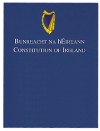And so the convention on our mercilessly caricatured Constitution has begun. The caricature of it is easy to spell out; it is  a Catholic document heavily influenced by Archbishop John Charles McQuaid and it is utterly of its time.
a Catholic document heavily influenced by Archbishop John Charles McQuaid and it is utterly of its time.
It is to be fervently hoped, therefore, that the Convention members had a good listen to the speech delivered by Justice Gerard Hogan on Saturday.
Hogan says straight out that the influence of McQuaid on the Constitution has been “overstated”. McQuaid only got involved late in the drafting process.
In fact, the chief Catholic influence was a Jesuit submission on the matter made in 1936. But this was not the chief influence by any means.
The main architect of the 1937 Constitution was John Hearne, legal adviser at the Department of Foreign Affairs who Hogan describes as “a hugely gifted lawyer with remarkable talents”.
He marvels at Hearne’s “peerless drafting skills”. He says: “It is a measure of Hearne’s unique talent that he could – and did – draft an entire document with little enough assistance in so short a period.”
Hogan bemoans the manner in which “the Constitution’s obvious strengths and considerable achievements are almost never mentioned” in public debate about it.
Hogan sets out the sources of the various articles of our Constitution very clearly.
For example, the role of President, including the seven year term, comes from the Constitution of the Weimar Republic.
The system of judicial review and the Supreme Court comes from the US Constitution.
The separation of powers also comes from the US Constitution.
Equality before the law and no titles of nobility comes from Weimar.
Protection of the family comes from Weimar and various Papal Encyclicals
Hogan here notes with a certain amount of irony “that the key language of Article 41 – ‘inalienable and imprescriptible rights, antecedent and superior to all positive law’ is taken verbatim from French Constitution of 1848”.
That Constitution was a moderate enunciation of the rights set out by the French Revolution and was not a Catholic document by any stretch of the imagination.
In busting some of the myths about our Constitution, paragraphs 14 through 18 of the Hogan address are particularly important.
In paragraph 14 he says: “Much of the criticism of the Constitution seems directed at the proposition that many of its provisions are unique and special to Ireland, redolent of an agrarian, nationalist and very religious society that is no more. I seriously dispute that proposition. I think that you would rather find that much of the Constitution has very close comparators – for the all the reasons that I have mentioned – with its continental counterparts.”
In paragraph 18 he states that while “some of the criticisms of the Constitution’s more contentious clauses [eg women in the home] are all too well-founded, the criticisms directed at the bulk of the document generally are not. It appears to be another example of all-too typically Irish characteristics of negativity, lack of self-belief and lack of civic pride in our institutions and in our own achievements.”
Every member of the Convention, and every presenter, research, producer, reporter, columnist and leader-writer whose head is full of lazy stereotypes about our Constitution ought to study Justice Hogan’s speech on the matter before ever uttering another thought on the matter.
(His address can be found at this link. It is listed among a number of other addresses)















